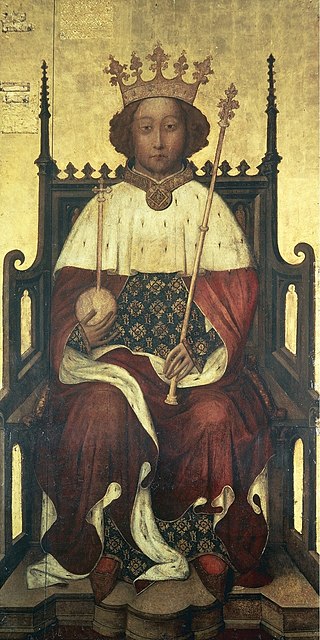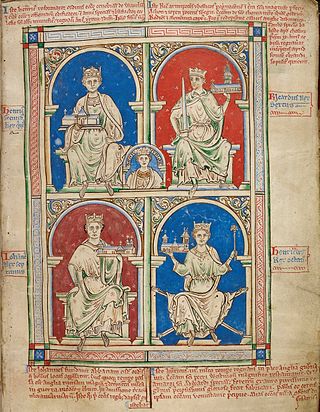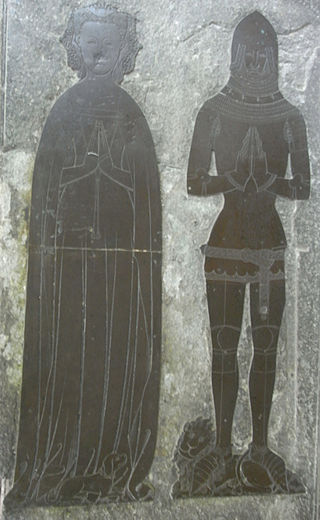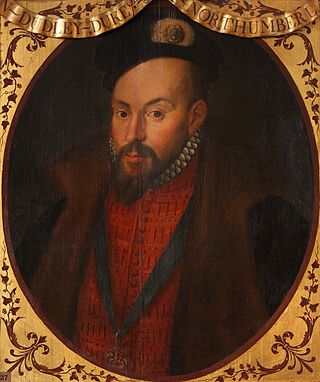Related Research Articles

Richard II, also known as Richard of Bordeaux, was King of England from 1377 until he was deposed in 1399. He was the son of Edward, Prince of Wales, and Joan, Countess of Kent. Richard's father died in 1376, leaving Richard as heir apparent to his grandfather, King Edward III; upon the latter's death, the 10-year-old Richard succeeded to the throne.

Thomas de Mowbray, 1st Duke of Norfolk, KG was an English peer. His family were ancient, and by the time Thomas reached adulthood, they were extremely influential in national politics. He himself claimed a direct bloodline from King Edward I. His father died when Thomas and his elder brother were young. However, John soon died, and Thomas inherited the Earldom of Nottingham. He had probably been friends with the king, Richard II, since he was young, and as a result, he was a royal favourite, a role he greatly profited from. He accompanied Richard on his travels around the kingdom and was elected to the Order of the Garter. Richard's lavish dispersal of his patronage made him unpopular with parliament and other members of the English nobility, and Mowbray fell out badly with the king's uncle, John of Gaunt.

Mary de Bohun was the first wife of Henry Bolingbroke, Earl of Northampton and Hereford and the mother of King Henry V. Mary was never queen, as she died before her husband came to the throne as Henry IV.

William de Longchamp was a medieval Lord Chancellor, Chief Justiciar, and Bishop of Ely in England. Born to a humble family in Normandy, he owed his advancement to royal favour. Although contemporary writers accused Longchamp's father of being the son of a peasant, he held land as a knight. Longchamp first served Henry II's illegitimate son Geoffrey, but quickly transferred to the service of Richard I, Henry's heir. When Richard became king in 1189, Longchamp paid £3,000 for the office of Chancellor, and was soon named to the see, or bishopric, of Ely and appointed legate by the pope.

England in the Middle Ages concerns the history of England during the medieval period, from the end of the 5th century through to the start of the early modern period in 1485. When England emerged from the collapse of the Roman Empire, the economy was in tatters and many of the towns abandoned. After several centuries of Germanic immigration, new identities and cultures began to emerge, developing into kingdoms that competed for power. A rich artistic culture flourished under the Anglo-Saxons, producing epic poems such as Beowulf and sophisticated metalwork. The Anglo-Saxons converted to Christianity in the 7th century, and a network of monasteries and convents were built across England. In the 8th and 9th centuries, England faced fierce Viking attacks, and the fighting lasted for many decades. Eventually, Wessex was established as the most powerful kingdom and promoting the growth of an English identity. Despite repeated crises of succession and a Danish seizure of power at the start of the 11th century, it can also be argued that by the 1060s England was a powerful, centralised state with a strong military and successful economy.

A church monument is an architectural or sculptural memorial to a deceased person or persons, located within a Christian church. It can take various forms ranging from a simple commemorative plaque or mural tablet affixed to a wall, to a large and elaborate structure, on the ground or as a mural monument, which may include an effigy of the deceased person and other figures of familial, heraldic or symbolic nature. It is usually placed immediately above or close to the actual burial vault or grave, although very occasionally the tomb is constructed within it. Sometimes the monument is a cenotaph, commemorating a person buried at another location.

Nigel was an Anglo-Norman clergyman and administrator who served as Bishop of Ely from 1133 to 1169. He came from an ecclesiastical family; his uncle Roger of Salisbury was a bishop and government minister for King Henry I, and other relatives also held offices in the English Church and government. Nigel owed his advancement to his uncle, as did Nigel's probable brother Alexander, who like Nigel was advanced to episcopal status. Nigel was educated on the continent before becoming a royal administrator. He served as Treasurer of England under King Henry, before being appointed to the see, or bishopric, of Ely in 1133. His tenure was marked by conflicts with the monks of his cathedral chapter, who believed that Nigel kept income for himself that should properly have gone to them.

In the history of England, the High Middle Ages spanned the period from the Norman Conquest in 1066 to the death of King John, considered by some historians to be the last Angevin king of England, in 1216. A disputed succession and victory at the Battle of Hastings led to the conquest of England by William of Normandy in 1066. This linked the Kingdom of England with Norman possessions in the Kingdom of France and brought a new aristocracy to the country that dominated landholding, government and the church. They brought with them the French language and maintained their rule through a system of castles and the introduction of a feudal system of landholding. By the time of William's death in 1087, England formed the largest part of an Anglo-Norman empire, ruled by nobles with landholdings across England, Normandy and Wales. William's sons disputed succession to his lands, with William II emerging as ruler of England and much of Normandy. On his death in 1100 his younger brother claimed the throne as Henry I and defeated his brother Robert to reunite England and Normandy. Henry was a ruthless yet effective king, but after the death of his only male heir William Adelin, he persuaded his barons to recognise his daughter Matilda as heir. When Henry died in 1135 her cousin Stephen of Blois had himself proclaimed king, leading to a civil war known as The Anarchy. Eventually Stephen recognised Matilda's son Henry as his heir and when Stephen died in 1154, he succeeded as Henry II.

The history of England during the Late Middle Ages covers from the thirteenth century, the end of the Angevins, and the accession of Henry III – considered by many to mark the start of the Plantagenet dynasty – until the accession to the throne of the Tudor dynasty in 1485, which is often taken as the most convenient marker for the end of the Middle Ages and the start of the English Renaissance and early modern Britain.

Thomas de Berkeley, 5th Baron Berkeley, The Magnificent, of Berkeley Castle and of Wotton-under-Edge in Gloucestershire, was an English peer and an admiral. His epithet, and that of each previous and subsequent head of his family, was coined by John Smyth of Nibley (d.1641), steward of the Berkeley estates, the biographer of the family and author of "Lives of the Berkeleys".

Gentry are "well-born, genteel and well-bred people" of high social class, especially in the past. Gentry, in its widest connotation, refers to people of good social position connected to landed estates, upper levels of the clergy, or "gentle" families of long descent who in some cases never obtained the official right to bear a coat of arms. The gentry largely consisted of landowners who could live entirely from rental income or at least had a country estate; some were gentleman farmers. In the United Kingdom, the term gentry refers to the landed gentry: the majority of the land-owning social class who typically had a coat of arms but did not have a peerage. The adjective "patrician" describes in comparison other analogous traditional social elite strata based in cities, such as the free cities of Italy and the free imperial cities of Germany, Switzerland, and the Hanseatic League.
Sir William Hankford, also written Hankeford, of Annery in Devon, was an English lawyer who acted as Chief Justice of the King's Bench from 1413 until 1423.
Dowry of Mary is a title used in Catholic contexts to refer to England. It dates back to medieval times and had become widespread by the middle of the fourteenth century. It reflects the deep devotion to Mary that existed in medieval England, and the belief that she took a particular protective interest in the country's affairs.
Mary Christine Carpenter is an English historian who was professor of medieval English history at the University of Cambridge.

Edward of Angoulême was second in line to the throne of the Kingdom of England before his death. Born in Angoulême, he was the eldest child of Edward, Prince of Wales, commonly called "the Black Prince", and Joan, Countess of Kent, and thus was a member of the House of Plantagenet. Edward's birth, during the Hundred Years' War, was celebrated luxuriously by his father and by other monarchs, such as Charles V of France.

An Esquire of the Body was a personal attendant and courtier to the Kings of England during the Late Middle Ages and the early modern period. The Knight of the Body was a related position, apparently sometimes merely an "Esquire" who had been knighted, as many were. The distinction between the two roles is not entirely clear, and probably shifted over time. The positions also existed in some lesser courts, such as that of the Prince of Wales.

Music in Medieval England, from the end of Roman rule in the fifth century until the Reformation in the sixteenth century, was a diverse and rich culture, including sacred and secular music and ranging from the popular to the elite.
Jennifer C. Ward was a British historian who was a specialist in medieval women and the history of Essex and East Anglia.

In post-classical history, an affinity was a collective name for the group (retinue) of (usually) men whom a lord gathered around himself in his service; it has been described by one modern historian as "the servants, retainers, and other followers of a lord", and as "part of the normal fabric of society". It is considered a fundamental aspect of bastard feudalism, and acted as a means of tying magnates to the lower nobility, just as feudalism had done in a different way.
In July 1385 Richard II, king of England, led an English army into Scotland. The invasion was, in part, retaliation for Scottish border raids, but was most provoked by the arrival of a French army into Scotland the previous summer. England and France were engaged in the Hundred Years' War, and France and Scotland had a treaty to support each other. The English King had only recently come of age, and it was expected that he would play a martial role just as his father, Edward the Black Prince, and grandfather Edward III had done. There was some disagreement amongst the English leadership whether to invade France or Scotland; the King's uncle, John of Gaunt, favoured invading France, to gain him a tactical advantage in Castile, the throne of which he claimed through his wife, Constance, with little success. The King's friends among the nobility – who were also Gaunt's enemies – preferred an invasion of Scotland. A parliament the year before had granted funds for a continental campaign and it was deemed unwise to flout the House of Commons. The Crown could barely afford a big campaign. Richard summoned the feudal levy, which had not been called for many years; this was the last occasion on which it was to be summoned.
References
- ↑ The Three Richards: Richard I, Richard II and Richard III: Nigel Saul: Books. Amazon.co.uk. 12 June 2006. Retrieved 24 August 2009.
- ↑ Saul, Nigel (2000). A Companion to Medieval England 1066–1485 (Paperback). ISBN 0752417851.
- ↑ "Richard II and the Crisis of Authority". BBC. 1 July 2001. Retrieved 24 August 2009.
- ↑ Walker, Simon (4 September 1997). "review of Richard II by Nigel Saul". London Review of Books. 19 (17): 16–17.